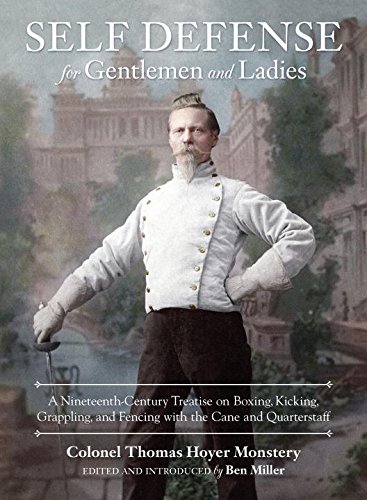- Originally published on the Bartitsu.org site on Wednesday, 8th October 2014
Advance notice that this book – a compilation of self-defence articles written by famed duelist, mercenary and raconteur Col. Thomas Hoyer Monstery – will be published in April of 2015.
According to the synopsis:
Self-Defense for Gentlemen and Ladies is the treatise of Colonel Thomas Hoyer Monstery, a master swordsman who participated in more than fifty duels, fought under twelve flags, battled gangsters, and was constantly involved in the great conflicts and upheavals of his time. Monstery’s treatise—originally published in the 1870s as a series of newspaper articles and collected here for the first time—is his magnum opus, a highly detailed dissertation on the art and science of defense. Filled with profound insight as well as practical advice based upon personal combative experience, it proposes a holistic approach to self-defense, including both unarmed and armed methods for use against a wide variety of fighting styles and weapons, as well as touching upon issues of health, exercise, diet and longevity.
Self-Defense for Gentlemen and Ladies presents a unique look into the Victorian fighting world, describing styles of the era such as British “purring” (shin-kicking), Welsh jump-kicking, and Danish head-fighting. Additionally, the book’s section on the quarterstaff is the only American source on this weapon prior to the 20th century. Aside from its historical value, however, Monstery’s teachings on unarmed self-defense, cane fighting, and responding to unpredictable situations are still useful today, especially for those martial artists focused on “real world” self-defense. Fifty rare drawings and photographs from the period provide a fascinating glimpse into Monstery’s world and training, while an extensive glossary of terms and an introductory biography of Colonel Monstery–including fascinating details of his many duels as well as his groundbreaking devotion to teaching fencing and self-defense skills to women–update Monstery’s text to make it accessible to a broad and modern audience.
CONTENTS
Colonel Thomas Hoyer Monstery: The Unknown American Martial Arts Master
I. Introduction.
II. The Logic of Boxing.
III. Standing and Striking.
IV. Advancing to Strike and Feinting.
V. Simple Parries in Boxing.
VI. Parries with Returns.
VII. Effective or Counter Parries in Boxing.
VIII. Offence and Defense by Evasions.
IX. Trips, Grips, and Back-Falls.
X. Rules for a Set-to with Gloves.
XI. Observations on Natural Weapons.
XII. The Use of the Cane.
XIII. The Use of the Staff.
Appendix: Monstery’s Rules for Contests of Sparring and Fencing
Glossary














